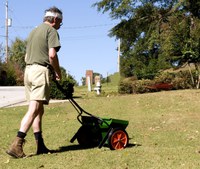Dakota Gardener: Applying fall lawn fertilizer in the northern Great Plains
(Click an image below to view a high-resolution image that can be downloaded)
By Esther E. McGinnis, Horticulturist
NDSU Extension
The seasonal window to fertilize your lawn is beginning to close. North Dakota State University Extension recommends the fall fertilizer application should take place around Labor Day. The fall application is the most important because it helps your cool season lawn recover from summer stresses. The nitrogen is useful in building a deep and robust root system which will pay dividends next year.
Exact timing over the Labor Day weekend is not required but fertilizing beyond the end of September is not recommended. Why so early?
University research conducted in Minnesota and Wisconsin shows that the lawn must be actively growing to take up the nitrogen fertilizer. In the experiment, soluble nitrogen was applied on the 15th of either September, October or November. For both states, the vast majority of nitrogen that was applied in September was taken up by the plant. October and November applications were wasteful and had the potential to either leach into the soil profile or into waterways with melting snow in spring.
Calendar recommendations are not entirely accurate because weather conditions fluctuate from year to year. However, the lawn is less likely to be actively growing once temperatures dip below 50 degrees Fahrenheit. To be on the safe side, NDSU Extension recommends applying a nitrogen fertilizer that is 50% slow release before September 15th.
Applying lawn fertilizer in October can be risky in some years because it can stimulate the lawn to actively grow rather than acclimate for winter. In years when cold weather comes early, this can result in winterkill.
During my first spring on the job, I visited a completely dead lawn. After asking multiple questions, I learned that a lawn service company had applied a quick release nitrogen fertilizer in October. The homeowner raved about how lush the lawn was in fall. This was the clue that we needed to diagnose the problem. The late fertilizer application caused the lawn to grow rather than shutting down for winter. I am not saying that October fertilizer applications will always kill your lawn but it does raise the risk of winterkill when winter comes suddenly.
Finally, is it worth it to put down a “winterizer” fertilizer product? A winterizer is a lawn fertilizer that contains high rates of potassium in addition to the nitrogen. The jury is still out on whether fall-applied potassium is beneficial in the north country. Research in southern states has shown that potassium can help warm season grasses like bermudagrass survive low winter temperatures. The winterizers you see on the market were developed for southern states.
More research is needed to study the impact of potassium on northern turfgrasses such as Kentucky bluegrass.
NDSU Agriculture Communication – Sept. 12, 2023
Source: Esther McGinnis, 701-231-7406, esther.mcginnis@ndsu.edu
Editor: Kelli Anderson, 701-231-7881, kelli.c.anderson@ndsu.edu




